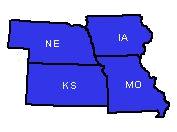Federal Agencies, Private Landowners Partner to Protect Wetlands
|
| Fact Sheets and Brochures Do I Need a Dredge and/or Fill Permit? (in Kansas) (PDF) (2 pp, 274K About PDF) Do You Need a Dredge or Fill Permit in Nebraska? (PDF) (2 pp, 133K About PDF) Stream Channelization (PDF) (4 pp, 404K About PDF) |
(Click on each state for maps and additional information)
A critical national goal for pollution control and natural resource protection is to slow the rate of wetlands loss and to gain at least 100,000 acres of wetlands each year by the year 2005. Over the past decade several federal agencies, working in partnership with private landowners, have protected and restored more than 180,000 acres of wetlands within Iowa, Nebraska, Kansas and Missouri, the four states that make up Region 7 of the U.S. Environmental Protection Agency. In 1998 alone, over 46,000 acres of wetlands were protected and restored. Historically, agricultural activities, urbanization, and hydrologic modifications have caused sharp reductions in the amount of natural wetlands. The most recent survey shows that the annual net loss of wetlands nationwide is about 100,000 acres. That means a net increase of 100,000 acres per year will require gross wetland gains of 200,000 acres a year.
Wetlands assimilate chemicals that otherwise would pollute our rivers and lakes. Their protection and restoration is an integral component of clean water planning. They are areas of high biological productivity, critical to any effort to maintain or restore populations of fish and wildlife and maintain diversity of species.
Federal agencies need to encourage and support the restoration and enhancement
of wetlands by working in partnership with landowners and communities
to achieve that net increase. They also need to ensure through the
regulatory program that there is no overall net loss of wetlands.
More than 120,000 acres of wetlands in Region 7 were protected in the
1990s in the USDA Natural Resources Conservation Service's Wetland
Reserve Program ![]() 40,000
acres protected in the department's Conservation
Reserve Program
40,000
acres protected in the department's Conservation
Reserve Program ![]() ;
and 15,000 acres in the U.S. Fish and Wildlife Service's Partners
for Wildlife program
;
and 15,000 acres in the U.S. Fish and Wildlife Service's Partners
for Wildlife program ![]() .
The net gain goal will require even stronger partnerships among federal
programs and those involved with non-federal efforts.
.
The net gain goal will require even stronger partnerships among federal
programs and those involved with non-federal efforts.
The Federal Highway Administration
(FHWA)![]() ;
has a goal of replacing wetlands at a ratio of at least 1.5 to 1.
That goal has been in the FHWA strategic plan and annual performance plan
since federal fiscal 1996 and has been maintained with a replacement ratio
of 2.4 nationally. Federal-aid highway projects have affected 6,788
acres of wetlands, which led to 16,004 acres of newly created wetlands.
This represents a replacement ratio of 2.4 nationally. FHWA supports
the development of environmental analytical models (such as watershed
planning models) to evaluate the effects of proposed projects and help
decision makers. FHWA also promotes initiatives to protect and enhance
ecosystems through inventories, partnerships with resource agencies, and
practices such as wetland banking.
;
has a goal of replacing wetlands at a ratio of at least 1.5 to 1.
That goal has been in the FHWA strategic plan and annual performance plan
since federal fiscal 1996 and has been maintained with a replacement ratio
of 2.4 nationally. Federal-aid highway projects have affected 6,788
acres of wetlands, which led to 16,004 acres of newly created wetlands.
This represents a replacement ratio of 2.4 nationally. FHWA supports
the development of environmental analytical models (such as watershed
planning models) to evaluate the effects of proposed projects and help
decision makers. FHWA also promotes initiatives to protect and enhance
ecosystems through inventories, partnerships with resource agencies, and
practices such as wetland banking.
Regulatory protections for wetlands, including those enacted by the 1985 Farm Bill, reduced the rate of wetland losses through the 1970s and 1980s. In the 1990s, these programs have become even more effective. Wetland regulation and enforcement will continue to play an important role in the overall wetland strategy as improvements in program effectiveness continue to reduce losses.
Yet small, piecemeal losses of wetlands and other aquatic habitats accumulate to create significant levels of environmental damage in many areas of the United States. One way to better protect these valuable resources is to integrate them into geographic-based planning programs. These include the watershed approach and other planning programs that address coastal resources, habitat, floodplains and river corridors, and management of water resources and public lands.
Federal agencies in the region are committed to partnerships that can make use of such available tools to protect and restore wetlands.
![[logo] US EPA](https://webarchive.library.unt.edu/eot2008/20090508130128im_/http://www.epa.gov/epafiles/images/logo_epaseal.gif)

